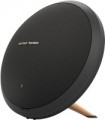Output power
The total power of all channels of the speaker system. The higher the power, the larger the size of the room in which the audio system can be used, however, more
powerful portable speakers usually have larger dimensions and weight.
Frequency range
The range of audio frequencies reproduced by the audio system. The wider the range, the richer the sound, the more details the speakers can convey, especially in the low and high frequencies. At the same time, we note that the average human ear is able to hear sounds in the range of about 16 – 20,000 Hz, and it makes no sense to provide a wider range in speakers — a person simply will not hear it. Also note that a wide frequency range alone does not guarantee good sound quality.
Features
—
Microphone for speakerphone. The ability to use portable speakers as a speakerphone system for conversations on a paired mobile phone. In this mode, the speakers connect to the device via Bluetooth, and the speech is transmitted to the interlocutor using the built-in microphone. The voice of the subscriber on the other end of the line is output not to the speaker of the phone, but directly through the speakers of the speaker system. This is often much more convenient than holding the phone close to the ear, or in situations when your hands are busy. In addition, speakerphone can be very useful if several people need to participate in the conversation.
—
NFC chip. NFC is a short-range wireless communication technology (about 10 cm). It allows for many different uses, but in portable speakers it is usually used as an addition to Bluetooth, making it easier to set up a communication. For example, a smartphone with an NFC module can simply be brought to a speaker with the same function — and both devices will automatically recognize each other, and the user will only need to confirm the communication.
—
Multipoint. The technology used in Bluetooth models allows the speaker to connect to several devices simultaneously. Thanks to this, you can, for example, listen to music from a laptop, and when a call comes in on your mobile phone, switch the speakers to a c
...onversation. Different manufacturers have their own features of this technology, and therefore, if the multipoint function is critical for you, you should separately clarify the details of its operation in the selected model.
— Bass Boost. A function that provides amplification of low frequencies — for powerful and rich bass. Often implemented as a single button, with which you can actually "turn the bass on and off." Bass Boost is more convenient than adjusting low frequencies using an equalizer; in addition, various special technologies can be used to enhance bass.
— Mobile application. The ability to operate the functions and settings of portable sound system through a mobile application for a smartphone or tablet. The device usually communicates with gadgets via the Bluetooth wireless protocol. The proprietary software may include tools for flexible sound adjustment (equalizer, bass boost, etc.), wireless communication management, sound source selection, etc. Also, the ability to update the firmware of portable sound system is often implemented through a mobile application.
— Light effects. Such effects can be different — from the simplest set of lights flashing at a constant frequency to advanced color music systems that produce multi-colored patterns in time with the music being played. In any case, this function has more of an entertaining meaning and does not affect the sound of the device in any way.Battery capacity
Theoretically, a
higher capacity allows to achieve greater battery life, but in fact, the operating time also depends on the power consumption of acoustics — and it can be very different, depending on the characteristics and design features. So this parameter is secondary, and when choosing it is worth paying attention not so much to the battery capacity, but to the directly claimed operating time (see below).
Battery life
Operating time of a portable audio system without connecting to an external power source (network or USB port, depending on the capabilities). Note that manufacturers tend to indicate battery life in their specifications under optimal conditions for energy saving: at low volume, without using additional functions, etc. Therefore, in fact, this indicator may be noticeably lower than the claimed one, and
speakers with a long operating time will not sound at full volume for the specified hours.

